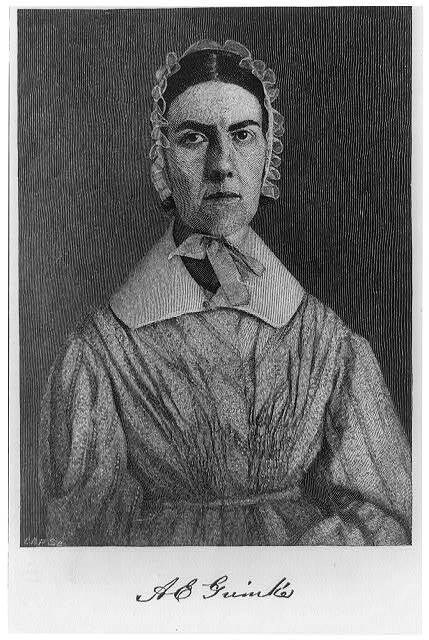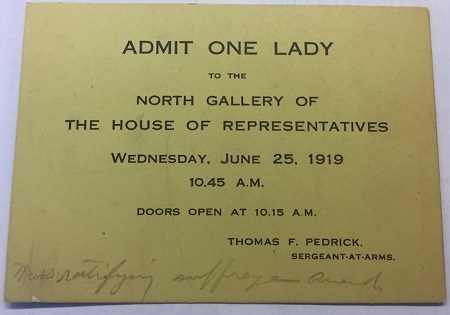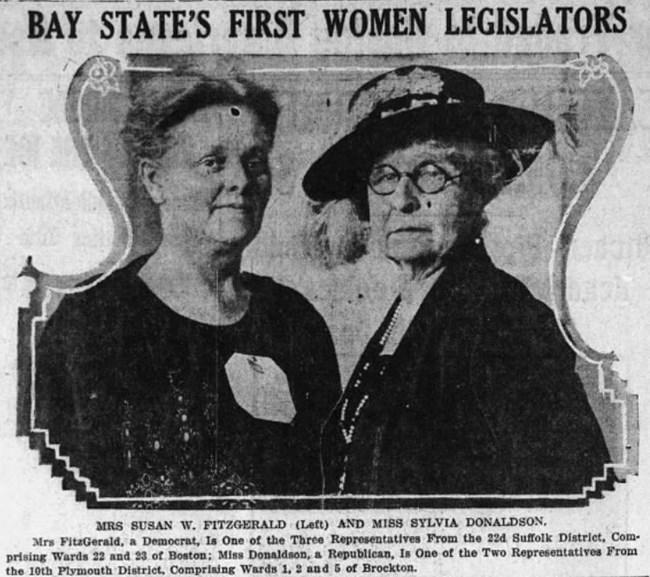Last updated: January 16, 2025
Article
Women's Suffrage at the Massachusetts State House
As one of the most esteemed suffrage battlegrounds in the Commonwealth, the Massachusetts State House served as the home to numerous speeches and hearings on women's suffrage. Suffragists and anti-suffragists petitioned, argued, and voted on suffrage throughout the decades-long fight for the vote.

Library of Congress
Angelina Grimké's Address, 1838
One of the earliest moments of the women's rights movement occurred within the State House. In February 1838, abolitionist and women’s rights activist Angelina Grimké spoke to the State Legislative Committee in Representatives Hall, becoming the first woman to address a United States legislative body. Representing 20,000 Massachusetts women petitioners, Grimké argued for the immediate end of slavery in front of an inter-racial audience of women and men.[1] During her multi-day testimony, Grimké also called on greater rights and civil freedoms for women, declaring, "This domination of woman must be resigned—the sooner the better; in the age which is approaching she should be something more—she should be a citizen."[2]
Abolitionists praised Angelina Grimké following her appearance at the Massachusetts State House. During a March 12 meeting of Black Bostonians in the Belknap-street School Room, leaders praised Grimké with a resolution:
That the superior intellect of A. E. Grimké, and its high cultivation,--her rhetorical powers, her love of justice, her ardent desire of doing good, and her well adapted eloquence in enforcing conviction, and making proselytes—render her an object of the highest admiration, and furnish another striking proof of that happy influence which women are capable of exerting in a community.[3]
Angelina Grimké's highly public speech at the Massachusetts State Legislature drew attention to both the abolition and women's rights movements. Activists involved in these two movements continued to draw connections between these causes over the following decades.
Suffrage Hearings
After Angelina Grimké's address, the Massachusetts State House remained a site of controversial debate for women’s suffrage. In 1869, Lucy Stone spoke in front of a joint committee on women’s suffrage, arguing in favor of changing the state constitution to expand the vote to women.[4] Hearings continued to occur over the following decades, often in response to women's petitions in favor and against women’s suffrage. Women suffragists frequently appeared at these hearings, and while men at first spoke on behalf of the remonstrants, or anti-suffragists, women anti-suffragists soon appeared for public testimonies as well.
As a result of these hearings and other pressure from suffrage organizations, the Massachusetts Legislature passed a law granting women the vote in school committee elections in 1879. While the Legislature defeated other municipal and state suffrage bills, they passed two state-wide suffrage referendums, one in 1895 (for municipal suffrage) and another in 1915. Despite the work of suffragists, neither of these referendums received enough popular support to pass.[5]

Papers of Florence Luscomb, Schlesinger Library, Radcliffe Institute, Harvard University.
Ratification
After years of petitioning, protesting, and demonstrating, Massachusetts suffragists won their final victory with the State Legislature’s ratification of the 19th Amendment. When the 19th Amendment went to the states in early June 1919, local suffragists called on elected officials "to vote for ratification at the earliest possible moment, and thus place our grand old Bay State where we wish always to see her—at the head of the procession of freedom."[6]
The Committee on Federal Relations held a day-long hearing on June 12. Reports indicated that hundreds of suffragists and anti-suffragists gathered for the day’s events, visually separated by red roses (worn by "antis") and yellow marigolds (worn by suffragists).[7] The pressure continued to mount over the next week, when the State Senate voted to ratify the Amendment on June 19 with a vote of 34-5-1.[8]
On June 25, suffragists overcame the final barrier—the Massachusetts House of Representatives. In describing the scene, The Boston Globe reported:
The galleries had been reserved entirely for women and an equal number of tickets distributed between the suffragists and the ‘antis.’ One gallery was accessible only to holders of red colored tickets and the other to those with yellow tickets. There were many more holders of yellow tickets who sought admission, showing the suffragists greatly outnumbered the ‘antis’.[9]
After close to 3 hours of debate, the House took its final vote, ratifying the 19th Amendment 185-47.[10] The room erupted in applause as suffragists and their allies celebrated their victory. Massachusetts became the eighth state to ratify the amendment.

Boston Globe, January 4, 1923.
Women in the State House
After the ratification of the 19th Amendment, some women entered the field of politics by running for state office. In 1922, Massachusetts elected its first female state representatives, Susan Fitzgerald (Democrat) and Sylvia M. Donaldson (Republican).[11]
Susan Walker Fitzgerald, an active and well-known Boston suffragist, had dedicated her life to the suffrage cause for the final two decades of the movement. She served in leadership positions in the Boston Equal Suffrage Association for Good Government and the Massachusetts Woman Suffrage Association, and took on national roles within the National American Woman Suffrage Association.[12]
Daughter of a former congressman, M. Sylvia Donaldson (or Sylvia M. Donaldson) had previously been a teacher in Brockton.[13] Donaldson continued to be active in the community following her retirement, and while not active in suffrage, she participated in several women’s groups and claimed to live by the motto "Service above self."[14] Donaldson won an additional "first" by serving as honorary Speaker of the House for one day in 1926.
Footnotes:
[1] “Meeting of Colored Citizens,” The Liberator, March 23, 1838; “(1838) Angelina Grimké, ‘Address to the Massachusetts Legislature,’” Blackpast, November 3, 2011, https://www.blackpast.org/african-american-history/1838-angelina-grimke-address-massachusetts-legislature/.
[2] Sally G. McMillen, Lucy Stone: An Unapologetic Life (Oxford: Oxford University Press, 2015).
[3] “Meeting of Colored Citizens,” The Liberator, March 23, 1838.
[4] Barbara Berenson, Massachusetts in the Woman Suffrage Movement (Charleston, SC: The History Press, 2018) 70-71.
[5] Berenson, Massachusetts in the Woman Suffrage Movement, 74, 78-81, 134.
[6] “Demand Bay State Be First to Ratify,” Boston Globe, June 9, 1919.
[7] “Argue Ratification of Woman Suffrage,” Boston Globe, June 13, 1919.
[8] “Suffrage Ratified by State Senate,” Boston Globe, June 20, 1919; 1919 Senate Bill 0609: Resolutions Ratifying the Proposed Amendment to the Constitution of the United States Related to Extending the Right of Suffrage to Women. State Library of Massachusetts, 1919. https://archives.lib.state.ma.us/handle/2452/310295.
[9] “Woman Suffrage Finally Ratified,” Boston Globe, June 26, 1919.
[10] “Woman Suffrage Finally Ratified,” Boston Globe, June 26, 1919; Journal of the House of Representatives of the Commonwealth of Massachusetts, June 1919. State Library of Massachusetts, 166-173. https://archives.lib.state.ma.us/handle/2452/796143.
[11] Cynthia M. Sullivan, “History of Women in Massachusetts Government, 1923-1980,” State Library of Massachusetts, http://www.mawomenscaucus.com/womens-caucus-history; “Two Women in Mass. State House” Boston Globe, November 9, 1922.
[12] “Susan Walker Fitzgerald Papers,” Bryn Mawr College, accessed March 2021, http://archives.tricolib.brynmawr.edu/resources/bmc-m19.
[13] “Women Legislators Had Busy Morning with Caucus and Photographers,” Boston Globe, January 2, 1923.
[14] “Two Women in Mass. State House” Boston Globe, November 9, 1922.
